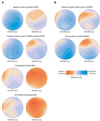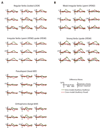An Event-Related Potential Study of Cross-modal Morphological and Phonological Priming
- PMID: 20160930
- PMCID: PMC2764258
- DOI: 10.1016/j.jneuroling.2009.07.001
An Event-Related Potential Study of Cross-modal Morphological and Phonological Priming
Abstract
The current work investigated whether differences in phonological overlap between the past- and present-tense forms of regular and irregular verbs can account for the graded neurophysiological effects of verb regularity observed in past-tense priming designs. Event-related potentials were recorded from sixteen healthy participants who performed a lexical-decision task in which past-tense primes immediately preceded present-tense targets. To minimize intra-modal phonological priming effects, cross-modal presentation between auditory primes and visual targets was employed, and results were compared to a companion intra-modal auditory study (Justus, Larsen, de Mornay Davies, & Swick, 2008). For both regular and irregular verbs, faster response times and reduced N400 components were observed for present-tense forms when primed by the corresponding past-tense forms. Although behavioral facilitation was observed with a pseudopast phonological control condition, neither this condition nor an orthographic-phonological control produced significant N400 priming effects. Instead, these two types of priming were associated with a post-lexical anterior negativity (PLAN). Results are discussed with regard to dual- and single-system theories of inflectional morphology, as well as intra- and cross-modal prelexical priming.
Figures





Similar articles
-
The role of Broca's area in regular past-tense morphology: an event-related potential study.Neuropsychologia. 2011 Jan;49(1):1-18. doi: 10.1016/j.neuropsychologia.2010.10.027. Epub 2010 Oct 28. Neuropsychologia. 2011. PMID: 21035476 Free PMC article.
-
Interpreting dissociations between regular and irregular past-tense morphology: evidence from event-related potentials.Cogn Affect Behav Neurosci. 2008 Jun;8(2):178-94. doi: 10.3758/cabn.8.2.178. Cogn Affect Behav Neurosci. 2008. PMID: 18589508 Free PMC article.
-
Decomposition of morphologically complex words in English: evidence from event-related brain potentials.Brain Res Cogn Brain Res. 1999 Jan;7(3):241-53. doi: 10.1016/s0926-6410(98)00028-7. Brain Res Cogn Brain Res. 1999. PMID: 9838144
-
Regularity re-revisited: modality matters.Brain Lang. 2004 Jun;89(3):611-6. doi: 10.1016/j.bandl.2004.01.004. Brain Lang. 2004. PMID: 15120552 Clinical Trial.
-
Cross-language phonological activation in bilingual visual word recognition: A meta-analysis.Psychon Bull Rev. 2025 Apr 11. doi: 10.3758/s13423-025-02692-8. Online ahead of print. Psychon Bull Rev. 2025. PMID: 40216667 Review.
Cited by
-
The role of Broca's area in regular past-tense morphology: an event-related potential study.Neuropsychologia. 2011 Jan;49(1):1-18. doi: 10.1016/j.neuropsychologia.2010.10.027. Epub 2010 Oct 28. Neuropsychologia. 2011. PMID: 21035476 Free PMC article.
-
ERPs and morphological processing: the N400 and semantic composition.Cogn Affect Behav Neurosci. 2013 Jun;13(2):355-70. doi: 10.3758/s13415-012-0145-3. Cogn Affect Behav Neurosci. 2013. PMID: 23271630
-
The generalizability issue in studying inflectional processing in real time: the potential effects of suffixal characteristics.Cogn Process. 2025 Jun 24. doi: 10.1007/s10339-025-01288-3. Online ahead of print. Cogn Process. 2025. PMID: 40553208
References
-
- Allen M, Badecker W. Inflectional regularity: Probing the nature of lexical representation in a cross-modal priming task. Journal of Memory and Language. 2002;46:705–722.
-
- Anderson JE, Holcomb PJ. Auditory and visual semantic priming using different stimulus onset asynchronies: An event-related brain potential study. Psychophysiology. 1995;32:177–190. - PubMed
-
- Baayen RH, Moscoco del Prado Martín F. Semantic density and past-tense formation in three Germanic languages. Language. 2005;81:666–698.
-
- Baayen RH, Piepenbrock R, Gulikers L. Linguistic Data Consortium. Philadelphia, PA: University of Pennsylvania; 1995. The CELEX Lexical Database (CD-ROM)
Grants and funding
LinkOut - more resources
Full Text Sources
Miscellaneous
